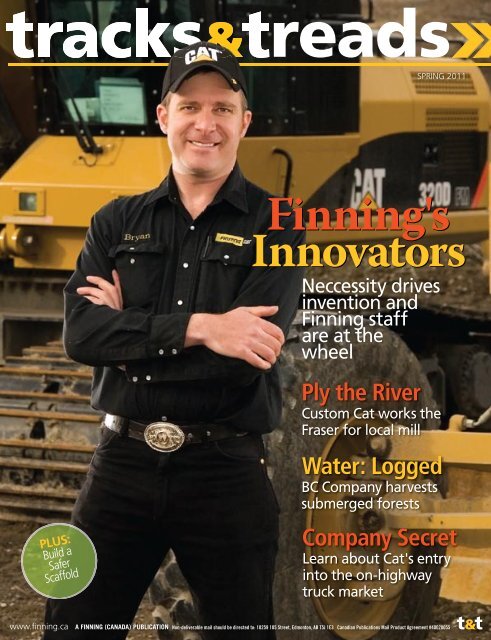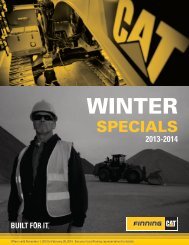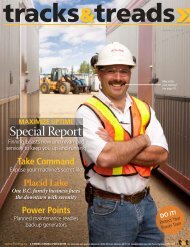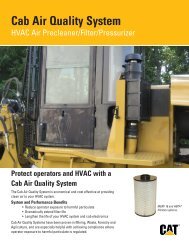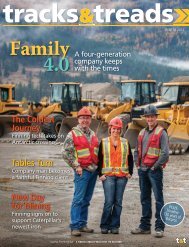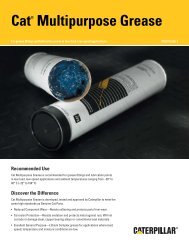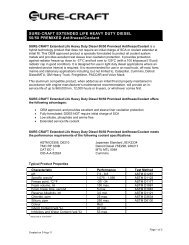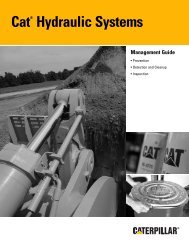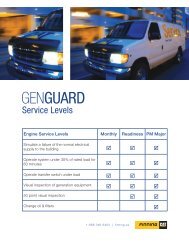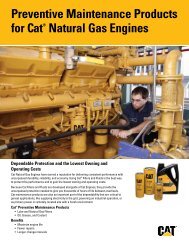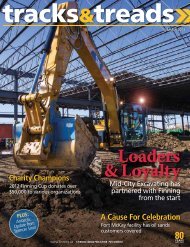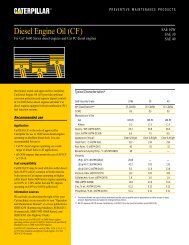Water: Logged Ply the River Company Secret - Finning Canada
Water: Logged Ply the River Company Secret - Finning Canada
Water: Logged Ply the River Company Secret - Finning Canada
You also want an ePaper? Increase the reach of your titles
YUMPU automatically turns print PDFs into web optimized ePapers that Google loves.
BIG SAVINGS. LASTING VALUE.Take advantage of low lease paymentson Cat ® machines. And protect yourinvestment with a Cat EquipmentProtection Plan.$298/mo *TO LEASE A CAT SKIDSTEER LOADER.Add a 3-year/3,000-hourEquipment Protection Planfor just $26/mo0% financing for 42 months!$504/mo * $470/mo * $949/mo *TO LEASE A CAT MULTI TERRAINLOADER. Add a 3-year/3,000-hourEquipment Protection Plan for just $56/moTO LEASE A CAT MINI HYDRAULICEXCAVATOR. Add a 3-year/3,000-hourEquipment Protection Plan for just $13/moTO LEASE A CAT BACKHOE LOADER.Add a 3-year/5,000-hour EquipmentProtection Plan for just $40/moContact your <strong>Finning</strong> representative today!1-888-finning | finning.ca(346-6464)* Offer good from February 1 to May 31, 2011 on select new models at participating Cat Dealers. Offer is available to customers in <strong>the</strong> USA and <strong>Canada</strong> onlyand cannot be combined with any o<strong>the</strong>r offers. For complete descriptions of <strong>the</strong> terms, conditions and exclusions of Equipment Protection Plans, pleasecontact your Cat Dealer. Suggested retail 60-month payment of preconfigured machine represents financing through Cat Financial and does not includetaxes, freight, set-up, delivery, additional options, or attachments.Financing and published rate are subject to credit approval through Cat Financial.Lease usage (hour limits) and application restrictions apply. A minimum of $1 million in liability coverage is required prior to funding. Additional termsand conditions may apply. Subject to change without prior notice.
ContentsSpring 116Columns & Departments4 <strong>Finning</strong> FocusWay to go, Jordy!5 LettersKids are cool for Cats6 GroundbreakerStill trucking, new IT system, miningacquisition, <strong>Finning</strong> and NAIT, newlocations, bright future, SAGD news9 By <strong>the</strong> Numbers10 Yesterday & TodayThe Russell grader11 Safety FirstBuild safety into scaffolding1616 Lost TreasuresA British Columbia logging company harvestsunderwater wood with <strong>Finning</strong>’s yellow iron20 Loaded for ServiceA high-tech oil filtration system and Cat comfortensures this log loader works for Richply2012 Manager’s TipsManage <strong>the</strong> old/young divide at work13 Operator’s TipsFive ways to kill a perfectly good dozer14 Tech SpotlightTime has come for Tier 4 tech32 PortraitBill Holmberg: At home in Houston33 Bill’s BusinessBill’s ladles up some tech advice34 Count on Us26 SPECIAL REPORTInnovation: <strong>Finning</strong> staff show that continuousimprovement is just ano<strong>the</strong>r service offering30 The <strong>Secret</strong>’s OutThere’s a new Cat truck coming26On <strong>the</strong> CoverBryan Kathan, <strong>Finning</strong> employeeinnovator from Fort McMurray.Photo: Rick Tolhurst12www.finning.ca tracks & treads Spring 2011 3
SPRING 2011 Volume 51, No. 1PUBLISHERRuth Kellyrkelly@venturepublishing.caEDITOR-IN-CHIEFJen Janzenjjanzen@finning.caASSOCIATE PUBLISHERJoyce Byrnejbyrne@venturepublishing.caEDITORMifi Purvismpurvis@venturepublishing.caCOPY CHIEFKim TannasEDITORIAL ADVISORSHilary Anaka, Jeff Howard,Michelle Loewen, Jeff WuiteART DIRECTORCharles Burkecburke@venturepublishing.caASSISTANT ART DIRECTORColin SpencePRODUCTION MANAGERVanlee RobbleePRODUCTION COORDINATORBetty-Lou SmithCIRCULATION COORDINATORJennifer Kingcirculation@venturepublishing.caADVERTISING REPRESENTATIVEAnita McGillisamcgillis@venturepublishing.caCayden Martens,François Lake, British ColumbiaMEXI-CATOn a recent trip to Mexico in January with my wife Birgit Billington (along-term <strong>Finning</strong> employee), we went to <strong>the</strong> local Walmart to pick up afew things. When we pulled into <strong>the</strong> parking lot, <strong>the</strong>re was this graderworking and I said, “I have to get a picture of this.” So I went to <strong>the</strong>fence to take a couple of pictures and <strong>the</strong> operator saw me. You couldtell that he was proud of his Cat grader and he waved me over so that Icould get a better picture with him operating it. I am a HD mechanic bytrade and I listened to <strong>the</strong> machine running and it ran great, no smoke,no hiccups at all. It’s not a new 24M, but it still gets <strong>the</strong> job done!Thanks,Jack Billington, Service Operations ManagerFort McMurray, AlbertaCONTRIBUTING WRITERSDavid DiCenzo, Cailynn Klingbeil, Martin Dover,Keith Haddock, Jon Moore, Geoff Morgan, Steve Penner,Remo ZaccagnaCONTRIBUTING PHOTOGRAPHERS AND ILLUSTRATORS3TEN Photo, Brnesh Berhe, Heff O'Reilly,Raymond Reid, Rick TolhurstTracks & Treads is published to provide its readerswith relevant business, technology, productand service information in a livelyand engaging manner.Tracks & Treads is published for<strong>Finning</strong> (<strong>Canada</strong>) byVenture Publishing Inc.10259-105 StreetEdmonton, Alberta T5J 1E3Phone: 780-990-0839Fax: 780-425-4921Contents © 2011 by <strong>Finning</strong> (<strong>Canada</strong>)No part of this publication should bereproduced without written permission.Tell us what you thinkTracks & Treads would love to hear from you. Tell us what you thinkof <strong>the</strong> magazine’s stories, columns and look, so that we can improveit and make it a more interesting read.Send your comments to editor-in-chief Jen Janzen by email atjjanzen@finning.ca or <strong>the</strong> old-fashioned way to: Jen Janzen, Tracks & Treads,<strong>Finning</strong> (<strong>Canada</strong>), 16830 – 107 Avenue, Edmonton, Alberta T5P 4C3www.fi nning.cawww.finning.ca tracks & treads Spring 20115
BY JEN JANZEN, CAILYNN KLINGBEIL AND MIFI PURVISStill TruckingCaterpillar is redefining <strong>the</strong> trucking business.At <strong>the</strong> ConExpo event in Las Vegas in March,Caterpillar launched its innovative CT660 HeavyDuty Class 8 Vocational Truck for <strong>the</strong> NorthAmerican market. This set-back axle day cab truckconfiguration will be <strong>the</strong> first of several modelsthat Cat will introduce in <strong>the</strong> next few years. Checkout www.DriveCat.com for a sneak peek, or turnto page 30 for an overview of <strong>the</strong> CT660.In addition to service and support for <strong>the</strong> newtruck, <strong>Finning</strong> is fully committed to supporting <strong>the</strong>thousands of Cat truck engines already on <strong>the</strong> roadtoday in Western <strong>Canada</strong>. Here are some of <strong>the</strong>most in-demand product and service supports that<strong>Finning</strong> is offering:Extended Service Coverages (ESC) – Warrantyprotection for newer engines, up to 10 yearsUsed Engine ESC – Protection for engines not yetready to overhaul, up to three yearsOverhaul Protection Trucks – Warranty coveragefor overhauled engines, up to four yearsPrecious Metals – Basic to full In-frame overhaulkits to add a second life to your engineComponent Plus – ESC for several separatecomponents purchased, up to four-year coverageCat Reman Components – Be environmentallyfriendly, and cost effectiveChassis Dyno Service – Know <strong>the</strong> condition ofyour engine<strong>Finning</strong> OverhaulsIT Systems<strong>Finning</strong>’s insides are getting an overhaul this year as <strong>the</strong> companyswitches its computer-based systems over to an enterprise resourceplanning (ERP) system.The new ERP, powered by Lawson Software Inc., will eventuallymerge <strong>Finning</strong>’s systems across alllocations in <strong>Canada</strong>, as well as across<strong>the</strong> company's business in <strong>the</strong> UK,Ireland and South America. At <strong>the</strong>same time, <strong>Finning</strong> will be changingsome of its business processes, workingto minimize any impacts on customers.Check out “We Are Making Changes”on www.finning.ca to read about somechanges you should expect soon.Caterpillar AcquiresBucyrusCaterpillar is fulfilling its goal of becoming a leader in<strong>the</strong> mining equipment industry with <strong>the</strong> acquisition ofmining equipment manufacturer Bucyrus International.Caterpillar CEO Doug Oberhelman says <strong>the</strong> transaction,worth $8.6 billion US, comes in response to Caterpillarcustomers’ requests. “For several years,” he says, “miningcustomers have been asking us to expand our range ofproducts and services to better serve <strong>the</strong>ir increasinglycomplex requirements.”Dave Parker, president of <strong>Finning</strong> (<strong>Canada</strong>), notes thatBucyrus equipment is popular at mine sites around <strong>the</strong>world, and its addition to <strong>the</strong> Caterpillar line will benefit<strong>Finning</strong> customers. “It constitutes a very broad productoffering for surface and underground mining,” he says,“making <strong>Finning</strong> a one-stop shop for mining needs.”Caterpillar intends to locate its mining businessheadquarters in South Milwaukee, Wisconsin, whereBucyrus headquarters is currently located. The closingof <strong>the</strong> transaction is expected to take place in mid-2011, subject to regulatory approvals and customaryclosing conditions and approval byBucyrus stockholders.6 tracks & treads Spring 2011www.finning.ca
Wave of <strong>the</strong> FutureMore of <strong>Finning</strong>’s newD7Es have been sold sinceSurmont Sand and Gravelbecame <strong>the</strong> fi rst <strong>Finning</strong>customer to purchase<strong>the</strong> machine. The D7E, aunique machine with anelectric hybrid engine, is<strong>the</strong> result of nearly twodecades of engine designand more than 100 patents.Four D7Es were recentlysold to Calgary's LyncorpInternational, with twodelivered in late 2010and two more deliveredat <strong>the</strong> start of this year.One D7E was also recentlysold to Nor<strong>the</strong>rn Alberta'sSucker Creek Holdings,with ano<strong>the</strong>r sale for <strong>the</strong>same company currently inprogress.The machine, whichboasts superior performanceand a smaller environmentalfootprint, is also part of<strong>Finning</strong>’s rental fl eet. “When<strong>the</strong>se tractors went out on<strong>the</strong>ir preliminary road showand customers got to use<strong>the</strong>m, <strong>the</strong>re was quite a lotof excitement about <strong>the</strong>m,”says Eric Shopland, rentaloperations manager with<strong>Finning</strong>’s heavy-equipmentrental fl eet. “They were wellreceived.”New LocationsA new <strong>Finning</strong> location is set to open in earlyApril in Tumbler Ridge, B.C., right around <strong>the</strong>same time that construction is scheduled tobegin on a facility in Fort McKay, Alberta, nearFort McMurray.<strong>Finning</strong> has rented a site just outside ofTumbler Ridge since 2005. The trailers formakeshift offices and large tents for storeinventory were no longer enough. “There wascustomer demand and a strong business caseto upgrade that facility,” says Drew Godley,director of facilities and property.<strong>Finning</strong> worked with a developer, who hasbecome <strong>the</strong> building’s landlord, to collaborateon <strong>the</strong> new location’s design. Along withwarehouse space and a front office, a smallerstorage unit currently under construction willprovide even more space.The Fort McKay location was a natural choice.“The volume of business in <strong>the</strong> oil sands and<strong>the</strong> amount of equipment that we have in thatregion has driven <strong>the</strong> need for increased shopspace in Fort McKay,” Godley says. The FortMcKay <strong>Finning</strong> location is scheduled to open in<strong>the</strong> fourth quarter of 2012.Mutual Interests<strong>Finning</strong> recently donated eight new engines to Nor<strong>the</strong>rnAlberta Institute of Technology (NAIT), part of a $3-millioncommitment between <strong>Finning</strong> and Caterpillar to NAIT’sIndustrial Heavy Equipment Technology (IHET) program.The 6.6-litre engines were donated last summer to replaceoutdated training engines, just in time for <strong>the</strong>ir usein <strong>the</strong> fall program.The IHET program is a two-year course divided into<strong>the</strong>oretical and practical learning. Hands-on experienceon <strong>the</strong> equipment is very valuable for students learninghow to put <strong>the</strong> <strong>the</strong>ory into practice.“Where <strong>the</strong>se engines really come into play,” says DaveScott, manager of learning and development at <strong>Finning</strong>,“is when students actually get practical exposure to <strong>the</strong>equipment prior to getting out into <strong>the</strong> field and workingon <strong>the</strong> equipment.”“With <strong>the</strong> close proximity and close relationship wehave with NAIT, and <strong>the</strong> size of NAIT as a technical trainingprovider, <strong>the</strong> rationale behind this donation was <strong>the</strong>yhelp us and we help <strong>the</strong>m to turn out quality apprentices,”says Scott.Of <strong>the</strong> $3-million donation to NAIT, <strong>Finning</strong> has committed$1-million worth of equipment, of which <strong>the</strong> enginesare part, along with ano<strong>the</strong>r $1-million in cash, and$1-million from Caterpillar, all over a five-year term.www.finning.ca tracks & treads Spring 2011 7
Beneath <strong>the</strong> SandsSTEAMINJECTIONDon’t Forget!Send us a picture of you in your Cat gear to win a $100 gift certificate tobuy even more Caterpillar loot. For more information, and to enter, visitwww.heavydutygear.ca/ShowUsYourGear.htm. Winners are announcedquarterly in 2011.BITUMENPRODUCTIONSAGD, or steam-assisted gravity drainage, hasbecome an increasingly effective method of extractionin <strong>the</strong> oil sands. This technology enhances oilrecovery, producing bitumen. It’s an advanced kindof steam stimulation in which site staff drill twohorizontal wells into an oil reservoir, positioning<strong>the</strong> petroleum intake line just a few metres below<strong>the</strong> steam injector line. Site staff inject low pressuresteam continuously into <strong>the</strong> upper wellbore toheat <strong>the</strong> oil and make it more viscose, or runnier.The heated oil drains into <strong>the</strong> lower wellbore, andpumps on <strong>the</strong> surface extract it.The process doesn’t impact land and water in <strong>the</strong>way that traditional mining operations do, makingSAGD operations a more environmentally-friendlychoice. Natural gas prices are low and looking to staythat way, lowering operating expenses for SAGDprograms. New projects and expansions that will takeadvantage of this innovative technology include:Firebag 3 – Suncor EnergyChristina Lake – Cenovus EnergyFoster Creek – Cenovus EnergySurmont – ConocoPhillips/Total E&P <strong>Canada</strong>Sunrise – Husky EnergyKirby – Canadian Natural ResourcesKijiji for Cat?Are you right-sizing your fl eet? Or are you looking to buy quality used Cat iron or parts? Ei<strong>the</strong>rway, visit www.finning.ca/Products/Equipment/Used_Equipment/Default.aspx. Ifyou’re looking to buy used, you can search by product or manufacturer; parts are searchableby part number. Your search will bring up pictures, hours, mileage, potential maintenance orrepair issues, location, special equipment and safety features and more. And if you’re a Catafi cionado, take a visit just for <strong>the</strong> heck of it. Lookie-loos are welcome.8 tracks & treads Spring 2011www.finning.ca
By <strong>the</strong> Numbers701976 3,500EconomicForecastLooksBrightThe future shows manypositive signs of postrecessionrecovery, asbusinesses and peoplemove beyond <strong>the</strong> uncertaintyand volatility thatsurrounded <strong>the</strong> outrightcontraction of <strong>the</strong> worldeconomy in 2009.According to TDEconomics most recentEconomic Forecast, <strong>the</strong>national outlook for 2011has brightened. They expectmomentum in bo<strong>the</strong>xports and investmentsto continue into 2012,though longer-termchallenges, such as highconsumer debt loads andweak overall productivity,are still factors thatwill affect recovery.The TD report carrieson to say that <strong>Canada</strong>’seconomy reboundedstrongly, and recovery isnow transitioning to amore moderate and sustainablepace. Real GDPgrowth is projected toaverage 2.6 per cent in2011, and 2.5 per centin 2012.Year Tim Hortonsintroduced <strong>the</strong> Timbitto its menuNumber ofparticipants in <strong>the</strong>world’s largestdodgeball game:Number of fouryeardegree1programs forconstructionproject managersin <strong>Canada</strong>:Estimated1project managersAnticipatedenrollment in SAITPolytechnic’s newBachelor of Sciencedegree in constructionproject management,which begins this fall:40Price of <strong>the</strong> nearly one-kilogram knife on Amazon$902.48Average number of millimeters ofrain annually in Prince Rupert, BC,<strong>Canada</strong>’s wettest cityCalories in an averageTim Hortons Timbit:20122020alreadyEstimated percentageof timber supplyimpacted by <strong>the</strong>mountain pine beetleinfestation in B.C.Number of toolscontained in <strong>the</strong>largest Swiss ArmyKnife:85Number of caloriesin a pound of bodyfat5.08Average number of minutesspent waiting in a TimHortons drive through inEdmontonTotal value of those projects:Number ofconstruction projectsei<strong>the</strong>r proposed oralready underway inAlberta:900$182 billionNumber ofannual Star Trekconventions heldworldwide:18Average number of millimeters ofrain annually in Whitehorse, YT,<strong>Canada</strong>’s driest city:2,470 163230Number of chaptersof <strong>the</strong> InternationalStar Trek Fan ClubCaptain Kirk actuallysaid “beam me upScotty”0 timeswww.finning.ca tracks & treads Spring 2011 9
BY JON MOOREILLUSTRATION BY BRNESH BERHE8 Steps to SafeScaffoldingWhen working on high, follow<strong>the</strong>se simple rules to ensure youcome back down safelyAccess ladder(mounted on end frame)Aluminum/plywoodcombination platformWhat goes up comes down again. When you’re dealing withscaffolding, that truism has an impact on safety. In January 2010,four men were killed on a worksite in Toronto when <strong>the</strong>ir scaffoldingfailed and <strong>the</strong>y plunged 13 stories. Subsequent investigationdetermined that <strong>the</strong>y had not been adequately trained on scaffoldingsafety.The sudden collapse of scaffolding or parts of it (such as <strong>the</strong>planking), and <strong>the</strong> potential to have <strong>the</strong> tools, materials or workerson <strong>the</strong> scaffold fall, are risks that can be controlled with properequipment and skills. Here are eight tips to make sure that neverhappens on your worksite.1. Perfect plumb: A scaffold must be nearly perfectly plumb –straight up and down. The CSA standard states that <strong>the</strong> scaffoldmust not deviate from <strong>the</strong> vertical by more than 12 millimetresper three metres of height or a total of 38 millimetres over itstotal height.2. Ladder matters: Portable ladders used to reach <strong>the</strong> work platformmust be secured at <strong>the</strong> top and <strong>the</strong> bottom, and must projectabove <strong>the</strong> work platform by at least one metre. O<strong>the</strong>r systemsinclude vertical stand-off ladders and scaffold stairway systemswith landings at regular intervals.3. Protection from <strong>the</strong> fall: Workers erecting or dismantlingscaffolding more than three metres above <strong>the</strong> ground must beprotected from falling.4. Standards standby: CSA International has a standard forscaffolds. Several Canadian jurisdictions have fairly detailed requirementsin <strong>the</strong>ir construction regs – B.C. has <strong>the</strong> most detailed – butall occupational health and safety legislation has a general dutyclause that requires taking “all reasonable measures,” meaningadherence to <strong>the</strong> CSA standard.5. Platform ply: The platform must be constructed of materialsthat meet certain standards. The usual choices are two-by-10 inchlumber; laminated wood planks specially rated for scaffold use; oraluminum or plywood panels designed for <strong>the</strong> purpose. There’sa distinction between <strong>the</strong> specifications for platform materialdesigned to support only workers and those designed to holdconstruction materials.6. Toe <strong>the</strong> line: The working platform of a scaffold has to have toeboards on at least <strong>the</strong> three outside edges to prevent tools and materialsfrom being accidentally kicked over <strong>the</strong> edge and falling on <strong>the</strong>people below. But <strong>the</strong>y also prevent workers on <strong>the</strong> platform fromstepping or slipping over <strong>the</strong> edge below <strong>the</strong> mid-rail.7. Guard your assets: The working platform at <strong>the</strong> top of <strong>the</strong> scaffoldhas to be protected by guardrails on at least <strong>the</strong> three sidesfacing away from <strong>the</strong> building if it is more than three metres above<strong>the</strong> ground or floor. If <strong>the</strong>re’s open space (such as a partially constructedbuilding) on <strong>the</strong> fourth side, or if <strong>the</strong> wall is more than 30centimetres from <strong>the</strong> edge of <strong>the</strong> scaffold, a guardrail may be needed<strong>the</strong>re as well.8. Looking up: Scaffolds tend to be metal structures erected closeto buildings and reaching high above <strong>the</strong> ground where <strong>the</strong>y are atgreat risk of coming close to electrical transmission lines.9 THINGS YOU DON’T WANT TO DONo jumping on planks or platforms.Don’t force braces to fit. Level <strong>the</strong> scaffold until a proper fit canbe made easily.Avoid climbing or standing on cross braces or guardrails.Stay off scaffolds during storms or high winds.Don’t use ladders or makeshift devices on top of scaffolds toincrease height.Avoid overloading scaffold frames or platforms.Don’t rest materials or equipment on guardrails.Throw out bent or kinked frames ra<strong>the</strong>r than trying to repair <strong>the</strong>m.Don’t work below a scaffold without head protection.www.finning.ca tracks & treads Spring 2011 11
TipsMANAGERSBridge <strong>the</strong> GapBY STEVE PENNERILLUSTRATION BY HEFF O'REILLYGrowing up in a particular decade can mark your attitudes,style of communication and values as clearly as can your country oforigin. In <strong>the</strong> workplace, sometimes it’s <strong>the</strong> way different generationsinteract that defines <strong>the</strong> corporate culture. In <strong>the</strong>ir influential bookGenerations: The History of America’s Future, researchers William Straussand Neil Howe sketched out a demographic <strong>the</strong>ory seminal in helpingemployers navigate <strong>the</strong> young/old divide.Of course, generalizations about <strong>the</strong> generations are just that. Agedefines a demographic, not a person.Part of <strong>the</strong> managerial tool box should include ways to cope with <strong>the</strong>tensions between <strong>the</strong> demographic groups on-site. There are strengthsand weaknesses to <strong>the</strong> way each group approaches work and managersshould try to anticipate <strong>the</strong> points of friction between <strong>the</strong>m. But here’sa cheat sheet that might tell you something about why Old Dave inwarehousing gives out dirty looks when <strong>the</strong> twenty-somethings cut outearly on a Friday.Who <strong>the</strong>y are:The Traditionalists are born between 1925 and 1942. They respectauthority and adhere to regulations. To <strong>the</strong>m, work is an obligation andexperience earns respect.The Boomers, born between 1946 and 1964, are associated with aredefinition of traditional values. In North America, Boomers grew upin a time of affluence. As a group, <strong>the</strong>y were <strong>the</strong> healthiest and wealthiestgeneration to that time.Generation X is that group born between 1965 and 1980. Gen-Xerstypically are self-reliant. They challenge o<strong>the</strong>rs and often question “Why?”They are entrepreneurial, value freedom and want constant feedback.Generation Y, born after 1980, is <strong>the</strong> fastest growing segment enteringGenerational differences can make forworkplace tension. Span <strong>the</strong> old-andyoungdivide by learning a little about it<strong>the</strong> work force. This cohort is tech savvy and achievement-oriented, thoughless willing to sacrifice <strong>the</strong>ir personal time to acquire that achievement.They’re confident, ambitious and are not afraid to question authority.How <strong>the</strong>y work:Get a new job: Traditionalists and Boomers see job changing as astigma – you only change jobs if you can’t succeed in your present job.Leaving often is a sign of failure. Gen-Xers view job change as a necessityfor advancement. Labelled “job-hoppers,” <strong>the</strong>y consider change a strategicimperative. They acquire an array of skills so current and potential employerssee <strong>the</strong>m as desirable candidates. Gen Y, on <strong>the</strong> o<strong>the</strong>r hand, wantsmeaningful, challenging work. Their loyalty can be earned with praise andconstant challenge.Get some feedback: Traditionalists assume that no news is good news.Short on praise and words, <strong>the</strong>y value authority and discipline. When <strong>the</strong>yhave something to say, pay attention. Boomers raised <strong>the</strong>ir children witha focus on self-esteem so <strong>the</strong>y’re more lavish with <strong>the</strong>ir praise. Gen-Xerswant feedback immediately or within a few days after completing a project.Technology plays a role, since Gen-Xers grew up online. Raised by thoseBoomers who believed in nurturing through positive feedback, a Gen Yemployee may not respond well to direct criticism.Get trained: Traditionalists attended <strong>the</strong> school of hard knocks. They don’ttolerate whiners and often believe younger employees are spoiled. Boomersfeel "younger people" do not have a strong a work ethic. Gen-Xers mightwant to keep learning new skills to increase <strong>the</strong>ir value in <strong>the</strong> workplace.They might leave an organization if <strong>the</strong>y feel <strong>the</strong>y aren’t getting enoughtraining. Gen-Yers feel empowered if <strong>the</strong>y’re engaged with <strong>the</strong> trainingprocess; encourage <strong>the</strong>m to use <strong>the</strong>ir know-how to coach older employeesin <strong>the</strong> use of tech tools and you’ll experience a win-win.12 tracks & treads Spring 2011www.finning.ca
OPERATORSNotes From<strong>the</strong> Driver’sSeatFive ways to wear out yourdozer before its timeBY GEOFF MORGAN ILLUSTRATION BY RAYMOND REIDDozers are a signature Cat product.They are engineered for tough work and are a greatchoice for applications including surface mining,cleanup, stock piles, road maintenance, reclamation andmore. A bulldozer is not a disposable tool.Dozers are for long-term use, but <strong>the</strong> way some tors treat <strong>the</strong>ir machines, it’s amazing <strong>the</strong>y last as long as<strong>the</strong>y do. <strong>Finning</strong>'s heavy construction/mining applicationopera-specialist, Brad Nunn, knows how to get <strong>the</strong> most outof his machines. There are a few simple rules that dozeroperators should follow, Nunn says, to keep <strong>the</strong> machineworking over <strong>the</strong> long term.DOWN THERE: “First and foremost,” Nunnsays, “The undercarriage is <strong>the</strong> most expensiveconsumable item on a dozer.” Keeping adozer’s undercarriage in good shape meansthat an operator should not put <strong>the</strong> machine in reverseat high speeds.BACK & FORTH: Nunn recommends thatoperators ensure <strong>the</strong>ir reverse distancedoesn’t exceed <strong>the</strong>ir forward distance,where possible. So, if you’re at a jobsite,and you’re approaching a load, say, five metres out, don’treverse seven metres.GEAR GUIDE: “Pick <strong>the</strong> right gear for<strong>the</strong> application,” Nunn says. An operatorusing high gear for a low-gear applicationwill quickly wear out a machine. There’s atemptation for operators to load a blade in second gearbecause <strong>the</strong> machine is driving faster. The problem isthat in second gear, <strong>the</strong> machine is using less horsepower.“This will give you longer life and less heat in yourtorque converter and drive-train components.” Use first gear to load your blade andcarry each load in second gear.BLADE RUINER: “Back blading is your worst enemy,” Nunn says. He’sreferring to <strong>the</strong> practice of dropping a dozer’s blade right onto <strong>the</strong> groundand putting <strong>the</strong> tractor in reverse. When an operator back blades, he ispulling a load ra<strong>the</strong>r than pushing it. “When you’re in reverse, if you havea load on <strong>the</strong> blade, you’re now putting unnecessary stress on your undercarriage,”he says. Dozers are built to push a load, not pull it. “If <strong>the</strong> dozer was meant to pushbackward, <strong>the</strong>y’d have put a blade on <strong>the</strong> back.”MR CLEAN: Running a clean machine is not about keeping a dozer lookingpristine. Maintaining <strong>the</strong> machine in this manner will actually allow it tocool itself properly. “You need to keep everything clean; meaning that youhave proper airflow through <strong>the</strong> radiators <strong>the</strong>mselves,” Nunn says. Airborneparticulates restrict airflow to a dozer’s radiator, making it run hotter. “So if you run yourmachine, let’s say, 20 degrees hotter than it should be, <strong>the</strong>n you’ve reduced its longevity.”www.finning.ca tracks & treads Spring 2011 13
Spot lightTECHTime for Tier 4Caterpillar’s Tier 4 engines faceindustry challenges head on,delivering performance andefficiency while meetingtough emissions standardsCaterpillar is leader in <strong>the</strong> delivery of dieselengines that meet government emissions standards,which are being phased in throughout <strong>the</strong> UnitedStates, <strong>Canada</strong>, Europe and Japan. Industry technologyrequires 15 parts per million Ultra Low SulphurDiesel Fuel (ULSD) for use in Tier 4 Interim engines.Cat engines use ULSD, and also low sulphated ashoils. These cleaner fuels and oils benefit <strong>the</strong> customer’sbottom line and his environment. They reduceash and maintain service intervals, contributingto low emissions and reducing operating costs.The new Cat engines will also have B20 biodieselcapability, adding greater sustainability wheredesired or required.The allowable amount of particulates and oxidesin emissions has been dropping since 1996 whenstandards were introduced. From Tier 1 (1996) toTier 3 (2006), emissions standards have dictatedan approximate drop of 60 and 65 per cent in <strong>the</strong>acceptable levels of particulates and oxides.The next, tougher, phase of emissions standards,called Tier 4 Interim in <strong>the</strong> US and <strong>Canada</strong>, tookeffect this year. Compared to Tier 3, Tier 4 Interimstandards require a 90 per cent reduction inparticulates and a 50 per cent decrease in oxides.Tier 4 Final, which will become effective in2014, dictates a a reduction to near-zero in<strong>the</strong>se emissions.14 tracks & treads Spring 2011www.finning.ca
MACHINE BREATHING Cat Tier 4 Interim engines feature improvedair-management systems to optimize airflow and enhancepower, efficiency and reliability. Cat applies simple, reliable turbochargingsolutions, based on engine size and application. Turboperformance is matched to rated output for high productivity,excellent fuel efficiency, long life and low operating costs.UNDER PRESSURE High pressure common rail fuel systems withfull electronic injection improve precision and control. The systemboosts performance and reduces soot for <strong>the</strong> following engines:C4.4 ACERT, C6.6 ACERT, C7.1 ACERT and C9.3 ACERT.POWERFUL ELECTRONICS The electronics used in Cat Tier 4Interim engines are more powerful and robust than ever. Morefeatures and better connection commonality improve <strong>the</strong> customerexperience. An over-foam wiring harness adds to reliabilityeven in <strong>the</strong> most demanding applications.TIONge IV (2014)50 bhp)*EMISSIONS REDUCTION (see chart below) The Cat NOxReduction System, <strong>the</strong> most reliable system of its type, capturesand cools a small quantity of exhaust gas, <strong>the</strong>n routes it backinto <strong>the</strong> combustion chamber where it drives down combustiontemperatures and reduces emissions of polluting oxides.0.60.540.2PARTICULATE MATTER (PM)0.026.66420.40109.21996Tier 1/Stage 12004Tier 22004Stage II2006Tier 3/Stage IIIA2011Tier 4 Interim/Stage IIIB2014Tier 4 Final/Stage IVwww.finning.ca tracks & treads Spring 2011 15
16 tracks & treads Spring 2011www.finning.ca
A British Columbia logging companyuses Cat equipment to harvest atrove of underwater woodBY CAILYNN KLINGBEILpicturesque inland lake, Ghana’sVolta Lake borders Digya National Parkon <strong>the</strong> western side of its 5,200-kilometreshoreline. Home to 90 per cent of Ghana’sinland fishery, 80,000 fishers ply its blue waters.But beneath that expansive surface standsano<strong>the</strong>r prize: an underwater forest.There’s <strong>the</strong> occasional sign of its existence,with trees poking from <strong>the</strong> surface here and<strong>the</strong>re, looking like crooked fingers. For <strong>the</strong> mostpart, <strong>the</strong> massive forest remains submerged,a state it’s been in since 1965 when <strong>the</strong> lake –actually a reservoir resulting from <strong>the</strong> dammingof two rivers – was created. But nowharvesters are bringing those trees surface-sideagain with <strong>the</strong> help of a B.C. company.Triton Logging Inc. specializes in underwaterharvesting and is set to begin logging <strong>the</strong>timber that remains perfectly preserved in <strong>the</strong>lake. And Triton is using its SHARC system (seesidebar, page 19), which includes a Caterpillarexcavator, to get <strong>the</strong> job done.Triton got its start in <strong>the</strong> underwater loggingbusiness, which traditionally involves smalloperations with divers using hydraulic chainsaws,when it saw <strong>the</strong> opportunity to mechanize<strong>the</strong> process. Using patented technology systemsto harvest underwater timber improves safetyand productivity.“The SHARC system, with <strong>the</strong> Caterpillarequipment, allows us to take proven forestryequipment and to add some unique and proprietarycomponents to it. We place it over<strong>the</strong> underwater forest and achieve similarproductivity that you would find withland-based mechanical logging,” says JimHayhurst, Triton’s vice president, businessdevelopment and global services.www.finning.ca tracks & treads Spring 2011 17
Lost TreasuresVOLTA LAKEUNDERWATER RESCUE: Triton's SHARC system relieson Caterpillar equipment to harvest submerged timber.In addition to Ghana, Triton is currently working in Brazil, wherea number of large hydro electric facilities and reservoirs have floodedareas of rainforest. “We have agreements with governments and withhydro managers to look at harvesting on three reservoirs in Brazil,”says Hayhurst.As Triton expands its project scope and builds more SHARC systems,<strong>Finning</strong> will benefit from <strong>the</strong> growth of <strong>the</strong> underwater loggingcompany. So too, it seems, will many o<strong>the</strong>rs. “The environmentalistslove it because we’re not impacting natural habitats,” says Hayhurst.“The technology geeks love it because it’s kind of cool, and <strong>the</strong> businesspeople love it because <strong>the</strong>re are really good returns and it’s a bigopportunity.”SHARCS: Meet <strong>the</strong> pod; (L-R) Lucas Miller,Stan Worsley, Richard Shipley and Rick Braun.The flooding of hydro dam reservoirs around <strong>the</strong> world iswhere Triton uses that equipment, as <strong>the</strong> oxygen-deprived environmentmeans wood-decaying fungi and microbes are unable to attack<strong>the</strong> wood, leaving trees dead, but in a preserved state.Triton estimates that some 300 million trees exist around <strong>the</strong>world in such underwater forests, a resource worth $50 billion. “It’sa huge resource, especially in a shrinking fibre basket, where livingforests are more and more important,” says Hayhurst, whose companyhas completed forestry projects in underwater forests from BritishColumbia to Sou<strong>the</strong>ast Asia.<strong>Finning</strong> got involved when Triton first approached <strong>the</strong>company to aid in <strong>the</strong> development of <strong>the</strong> SHARC system.“<strong>Finning</strong> was great,” says Hayhurst. “I think <strong>the</strong>y were really curiousabout <strong>the</strong> project when we approached <strong>the</strong>m – but we’ve known<strong>the</strong>m and <strong>the</strong>y’ve known us for a bit. Previously, we were just using<strong>the</strong>ir machinery in traditional ways, so when we said ‘this is what wewant to do, we have <strong>the</strong> designs and we’d like to use <strong>the</strong> Cat systemas <strong>the</strong> basis of it,’ <strong>the</strong>y worked with us to integrate that system.”Ano<strong>the</strong>r benefit of working with <strong>Finning</strong>, says Hayhurst, is <strong>the</strong>company’s worldwide network. “We’re based in B.C. but <strong>the</strong> majorityof our harvesting actually takes places overseas. Having that globalnetwork is really important to us.”Triton’s Ghana project is its biggest job yet. The company has20 employees working <strong>the</strong>re, and expects to deploy more equipmentand people to <strong>the</strong> country. “We’ll be working hard to ensurethat <strong>the</strong> value of Volta Lake grows exponentially over time,” saysHayhurst. In March, Triton began working under a 25-year har-18tracks & treadsSpring 2011www.finning.ca
HOW THE SHARC BITES (TREES)Triton originally used a system called <strong>the</strong> Sawfish to harvesttrees in deep water reservoirs. The Sawfish is a patentedvehicle system remotely operated by a pilot in a control roomon a barge. Harvesting operators have successfully used <strong>the</strong>system in nor<strong>the</strong>rn <strong>Canada</strong>, Sou<strong>the</strong>ast Asia and <strong>the</strong> UnitedStates. But work in <strong>the</strong> tropics, where submerged timbertends to stand in shallower water, meant Triton had toinnovate. That’s how it came to its SHARC system.The SHARC system harvests in depths up to 25 metres,though new versions of <strong>the</strong> SHARC, now in <strong>the</strong> planningstages, will operate in depths up to 37 metres.A single pilot operates <strong>the</strong> SHARC, with all navigational,cutting, tracking and retrieval software integrated into <strong>the</strong>cab. Information from video, maps and sonar equipment,available on interactive multi-view displays in that cab, helpguide <strong>the</strong> pilot to <strong>the</strong> underwater trees.The SHARC is a barge-mounted, self-contained surface systemcomprising four main components: a sectional barge thatmoves by itself and doesn’t have to be towed, a Caterpillarexcavator, a telescopic arm mounted on <strong>the</strong> excavator and acutting head at <strong>the</strong> end of <strong>the</strong> arm.After trees are located using on-board technology, <strong>the</strong>telescopic arm extends <strong>the</strong> cutting head to <strong>the</strong> base of <strong>the</strong>tree, where <strong>the</strong> grapple cutting head, with a 1.5-metre opening,attaches to <strong>the</strong> tree and <strong>the</strong> saw cuts through its base.When <strong>the</strong> tree is lifted up, <strong>the</strong> GPS automatically marks<strong>the</strong> cleared area on a map. The tree stem is <strong>the</strong>n raised to<strong>the</strong> surface and rotated into a floating bunk storage system,and once that system is full, <strong>the</strong> bunk is towed by tugboatto <strong>the</strong> shore. The bunks are <strong>the</strong>n unloaded at <strong>the</strong> shore andtaken to staging areas, where logs are sorted and readied fortransportation or milling.vesting license for 350,000 hectares of <strong>the</strong> submerged forest – anunderwater resource that is <strong>the</strong> largest and most valuable of its kindin <strong>the</strong> world. “The base log value we believe is about $1.5 billion,”says Hayhurst.The project is significant for both Triton and <strong>the</strong> country ofGhana, where Volta Lake serves as a huge transportation corridor.“As you can imagine, with trees sticking out of <strong>the</strong> lake, it’s quitedangerous,” says Hayhurst. “They’ve had a lot of accidents and deathsin <strong>the</strong> past from people hitting trees with <strong>the</strong>ir boats. So part of ourproject is also about clearing channels, and clearing areas where boattraffic can go and not have to worry about hitting trees.”After Triton’s SHARC system brings up logs from <strong>the</strong>underwater forest, <strong>the</strong> wood will go to both international and localmarkets. The wood is treated like any o<strong>the</strong>r wood: cut, dried, and<strong>the</strong>n used in a variety of ways, “anything that regular wood gets usedfor,” says Hayhurst.“There’s probably a couple dozen tree species that we’ll find underwaterin Ghana and many of <strong>the</strong>m are quite valuable, as <strong>the</strong>y arespecies that are difficult to find on land,” Hayhurst says.Because of <strong>the</strong> low environmental impact of <strong>the</strong> SHARC system,which doesn’t disturb <strong>the</strong> lake bed or kick up dirt in <strong>the</strong> water, <strong>the</strong>wood can be certified by <strong>the</strong> Rainforest Alliance’s SmartWoodRediscovered Wood program, making it a sought-after product foranyone seeking an environmentally sound wood choice.“It’s in demand around <strong>the</strong> world for its environmental credentialsand also because it’s kind of a cool story,” Hayhurst says. “People cansay, ‘I have wood that came from a forest that was flooded 40 yearsago’, and that’s quite remarkable.”Wood harvested from Volta Lake will be available locally for useby Ghanaian companies, while o<strong>the</strong>r wood will be sold in high-endmarkets around <strong>the</strong> world. Wood harvested by Triton has previouslybeen used to make a temple in Japan, a green building developmentin Victoria, and has been sold to high-end luxury resorts and furniturecompanies.“At <strong>the</strong> end of <strong>the</strong> day, it’s just like any o<strong>the</strong>r wood,” Hayhurst says,“except it comes with this incredible story and this great environmentalbenefit.”www.finning.ca tracks & treads Spring 2011 19
SPACE AGE: Modifications including a custom cab and an oilfiltration system designed by NASA set this 345CLL apart.20 tracks & treads Spring 2011www.finning.ca
BY DAVID DICENZOhere’s a new fixture dotting <strong>the</strong> landscape when you drive by <strong>the</strong>Fraser <strong>River</strong> in Richmond, B.C. Underneath <strong>the</strong> Knight Street Bridge sits a massiveCaterpillar 345CLL log loader, owned by Richmond <strong>Ply</strong>wood CorporationLimited, which operates a mill right on <strong>the</strong> banks of <strong>the</strong> river. Twenty-four hours a day,seven days a week, <strong>the</strong> Cat sits stationary, yanking logs from a boom. The logs will soonbe stripped to make plywood before being delivered to destinations around <strong>the</strong> globe.“The machine is absolutely huge,” says Gary Sigsworth, <strong>Finning</strong>’s general line salesrep at <strong>the</strong> Surrey branch. “It’s in such a spot that you can see it whenever you drive by<strong>the</strong> mill. You see this big Cat monstrosity pulling logs – it’s great.”Sigsworth’s exuberance comes from a simple fact. This specific log loader is <strong>the</strong>first Cat owned by Richply (as <strong>the</strong> company is popularly known), which was originallyfounded by a group of 300 men in 1956. The company is one of North America’slargest producers of plywood, peeling almost 500,000 cubic metres of logs per yearand creating product that goes to Japan, England, Scotland, Italy, Germany and <strong>the</strong>United States, among o<strong>the</strong>r countries.The province once had plywood companies numbering in <strong>the</strong> 30s but is now downto nine mills, with Richply and its almost 400 employees one of <strong>the</strong> biggest producers,and <strong>the</strong> lone one left on <strong>the</strong> Lower Mainland.Any business that has successfully operated for more than half a century goesthrough change. And Richply is no exception. When longtime mobile equipmentsupervisor John Robinson, a dedicated employee since 1975, was in <strong>the</strong> market for anew loader for Richply, he decided to go with <strong>the</strong> Caterpillar. The decision, he says,was based on one factor: <strong>Finning</strong>’s superior service. Robinson was familiar withmany members of <strong>the</strong> <strong>Finning</strong> family, employees who had often helped him obtainparts in <strong>the</strong> past.What he has come to learn since getting <strong>the</strong> 345CLL running in early October isthat <strong>the</strong> iron <strong>Finning</strong> sells and services is pretty good, too.“It’s a beautiful piece of equipment,” says Robinson, a Montreal native who grew upin Toronto before settling in British Columbia. “All of our operators – and we havea lot of <strong>the</strong>m on <strong>the</strong> one machine because we run it three shifts a day, seven days aweek – <strong>the</strong>y all say <strong>the</strong> same thing, that it’s like sitting in <strong>the</strong>ir living room at home.“We put 2,000 hours on it in just four months. And we haven’t had to touch it.”But Robinson’s loader is no ordinary piece of equipment. Given its unique application,sitting by <strong>the</strong> river and removing logs to put onto <strong>the</strong> conveyor, Richply hadmanufacturer Weldco-Beales make some modifications, namely a customized boomstick, heel and grapple and manufactured cab. Weldco-Beales raised <strong>the</strong> operator’sseat by two feet at Robinson’s request to provide better visibility, making it a “Westwww.finning.ca tracks & treads Spring 2011 21
Loaded for ServiceHEAVY LIFTING: The loader is a permanent fixturealong <strong>the</strong> Fraser <strong>River</strong>.Coast cab,” meaning <strong>the</strong> design is bigger on <strong>the</strong> inside and <strong>the</strong> cab isaccessed from <strong>the</strong> deck of <strong>the</strong> machine, ra<strong>the</strong>r than <strong>the</strong> side.“They are a long way off of <strong>the</strong> ground,” Robinson says of hisoperators.The more significant change is<strong>the</strong> high-tech filtration system thatwas installed to keep <strong>the</strong> machine’soil as clean as possible. Six largecans that measure approximately24 inches tall by 12 inches in diameterare mounted on <strong>the</strong> log loader’swalkway, close to <strong>the</strong> fuel tanks. Three of <strong>the</strong> cans are associated with<strong>the</strong> engine, while <strong>the</strong> o<strong>the</strong>r three are for <strong>the</strong> hydraulic system.Richply changes <strong>the</strong> oil and filters with every 2,000 hours of use.This means that <strong>the</strong> Cat was ready for maintenance after its first fourmonths of heavy work. Because of <strong>the</strong> modified filtration system,he expects <strong>the</strong> oil, which is tested in Edmonton, will come backextremely clean.All of Richply’s loaders are fitted with this unique filtration system.Robinson says <strong>the</strong> work environment on <strong>the</strong> Fraser <strong>River</strong> is actuallyvery clean but, back in <strong>the</strong> mid 1980s, <strong>the</strong> company encountered aproblem with contamination in <strong>the</strong> mill. He contacted a companycalled Harvard Filtration to assist in addressing <strong>the</strong>issues.Robinson ultimately dealt directly with ano<strong>the</strong>rorganization – one that had literally sent people to <strong>the</strong>moon.“We installed a bunch of <strong>the</strong>ir (Harvard’s) equipmentto try and clean up some of <strong>the</strong> hydraulic reservoirs on<strong>the</strong> big equipment,” says Robinson. “We had some problemsand Harvard hooked me up with a fella in NASA.”Yes, that NASA.“It was extremely cool. The guy would call me up atnine in <strong>the</strong> morning and B.S. with me on <strong>the</strong> phone foran hour.” Through <strong>the</strong> course of <strong>the</strong>se conversations,Robinson figured out what <strong>the</strong> problems were.“Nobody else really understood how <strong>the</strong> filtrationsystem worked, but <strong>the</strong> space program people understood.They know exactly how to get <strong>the</strong>ir oil down towhere it’s so damn clean <strong>the</strong>re are just no wear particlesin it at all, and still not touch <strong>the</strong> additive package.”Robinson jokes that <strong>the</strong> oil is probably cleaner whenOF THE ALMOST HALF A MILLION CUBICMETRES OF WOOD PROCESSED BY RICHPLYYEARLY, EVERY LAST PIECE OF FIBRE THATCOMES INTO THE MILL WILL GET HANDLED BYTHE MACHINE, SO RELIABILITY IS CRITICAL.it comes out of <strong>the</strong> machine than when <strong>the</strong>y put it in brandnew. To put it into <strong>the</strong> machine, <strong>the</strong> oil is charged through asophisticated system of couplings so that it’s never actuallyexposed to <strong>the</strong> air. He jokes, but <strong>the</strong> results are serious stuff.Because of <strong>the</strong> decrease in wear, <strong>the</strong> life of <strong>the</strong> machine isextended. Dramatically.The typical life expectancy of <strong>the</strong> 345CLL would be in <strong>the</strong>neighbourhood of 50,000 hours in any standard application.But Richply’s augmented machine could possibly double thatoutput. “I assume it will do at least 100,000,” says Robinson.“There is no contamination in <strong>the</strong> oil so <strong>the</strong>re’s no wear. If itdoesn’t wear out, it seems to run forever.”Of <strong>the</strong> almost half a million cubic metres of woodprocessed by Richply each year, every last piece of fibrethat comes into <strong>the</strong> mill will get handled by <strong>the</strong> machineso reliability is critical to <strong>the</strong> entire operation. Switchingfrom <strong>the</strong>ir old brand of choice has worked out with <strong>the</strong> veryvisible Caterpillar, tucked under <strong>the</strong> Knight Street Bridge,proving its worth daily.“With <strong>the</strong> expertise of forestry manager Dave Aldridge and partsperson Ken Brew, we were able to show <strong>the</strong>m why <strong>the</strong> Cat was better,”Sigsworth says. “And John signed off on it. It’s a purpose-built log loader.”Robinson says that <strong>the</strong> plywood industryas a whole has been sufferingfor a variety of reasons. There is <strong>the</strong>world economy and falling housingstarts in <strong>the</strong> United States. The strongCanadian dollar has also impactedforest companies negatively. Withso many of Richply’s customers abroad, exports take a big hit and <strong>the</strong>company receives less for its product.Despite facing some difficult challenges in its unique market,Richmond <strong>Ply</strong>wood Corporation Limited continues to chug along.With a new addition to its fleet of equipment and an innovativemodification that will help that loader live a longer life, <strong>the</strong> 55-year-oldcompany is poised to remain a heavyweight.“We actually produced more this year than last year,” saysRobinson.That’s as good a sign as any. As for <strong>the</strong> potential to add more yellowiron in <strong>the</strong> future, Robinson’s response is succinct: “Yes!”LOGGING HOURS: The loader runs threeshifts a day, seven days a week.22tracks & treadsSpring 2011www.finning.ca
navigates wea<strong>the</strong>r, wasteBY REMO ZACCAGNAFreezing wind chills, drifting snow,frost biting at any piece of skin that’s exposed:a Peace Country winter can be unforgivingfor even <strong>the</strong> toughest nor<strong>the</strong>rn residents.This last winter proved to be a challenging onein <strong>the</strong> County of Grande Prairie. Winter broughtnumerous freeze/thaw cycles and near-recordsnowfall in January that accounted for nearly aseason’s worth of <strong>the</strong> white stuff in just a few weeks.Encompassing <strong>the</strong> City of Grande Prairie andsurrounding areas, <strong>the</strong> County has a populationor more than 18,000 and covers 5,570 squarekilometres. Though <strong>the</strong> wea<strong>the</strong>r was unpredictable,<strong>the</strong> County’s fleet of Cat equipment performedadmirably, clearing and removing snowfrom local roads, says public works superintendentHerb Pfau.www.finning.ca tracks & treads Spring 2011 23
Portrait: Bill Holmberg<strong>Finning</strong> Branch 32is in Houston, B.C., on<strong>the</strong> Yellowhead Highwaynorthwest of PrinceGeorge. It’s a small branchand sales branch managerBill Holmberg has to do alittle of everything. Nowin his 17th year at <strong>Finning</strong>,Holmberg works in conjunctionwith his customerservice manager to overseea staff of 21.Holmberg closed hisforestry servicing businessof 15 years to work for<strong>Finning</strong>, first doing demosof yellow iron and trainingoperators. Because ofthis experience and <strong>the</strong>fact that he’s a heavy dutymechanic with a Class 1license, he says he “speaks<strong>the</strong> same language” ashis customers. And hisapproach to work reflectsthat.Holmberg's philosophyis to follow <strong>the</strong> GoldenRule. “I learned thatyou should treat people<strong>the</strong> way you want to betreated,” he says. “And youhave to keep <strong>the</strong> peoplearound you engaged inwhat <strong>the</strong>y’re doing. Workhard, but have fun at work.If you don’t like it, whywould you do it?”Holmberg transferred toHouston from VancouverIsland, where his kids andgrandkids live, nearly eightyears ago, intending to staya couple of years. But heand his wife, Laurel, bothHarley Davidson enthusiasts,fell in love with place,bought an acreage andshow no signs of leaving.32 tracks & treads Spring 2011www.finning.ca
www.finning.ca tracks & treads Spring 2011 33
Count on UsIN THE BEGINNING...Before <strong>the</strong>re was <strong>the</strong> yellow ironmanufacturer we know in this day,<strong>the</strong>re was <strong>the</strong> Holt Manufacturing<strong>Company</strong> and <strong>the</strong> C. L. Best Tractor<strong>Company</strong>. A Best machine is shownhere in this shot from forestry’sfledgling days.The two companies merged in1925, creating <strong>the</strong> CaterpillarTractor <strong>Company</strong>.34 tracks & treads Spring 2011www.finning.ca
Big MachinesBig OpportunitiesOur commitment to customer service hasbeen <strong>the</strong> backbone of our operationfor more than 75 yearsEvery individual, regardless of responsibilities, relies on teamwork toget things done. We know that <strong>the</strong> highest quality work comes fromcombining <strong>the</strong> skills and expertise of people and providing <strong>the</strong> support<strong>the</strong>y need to take personal responsibility for <strong>the</strong>ir own success, and for<strong>the</strong> success of <strong>the</strong> team.As a growing company, we are in constant need of skilled, experiencedand dedicated people to help us maintain our leading position in <strong>the</strong>industry.With operations throughout Western <strong>Canada</strong>, big opportunities await.Join <strong>the</strong> <strong>Finning</strong> team today!1-888-finning(346-6464)finning.ca


